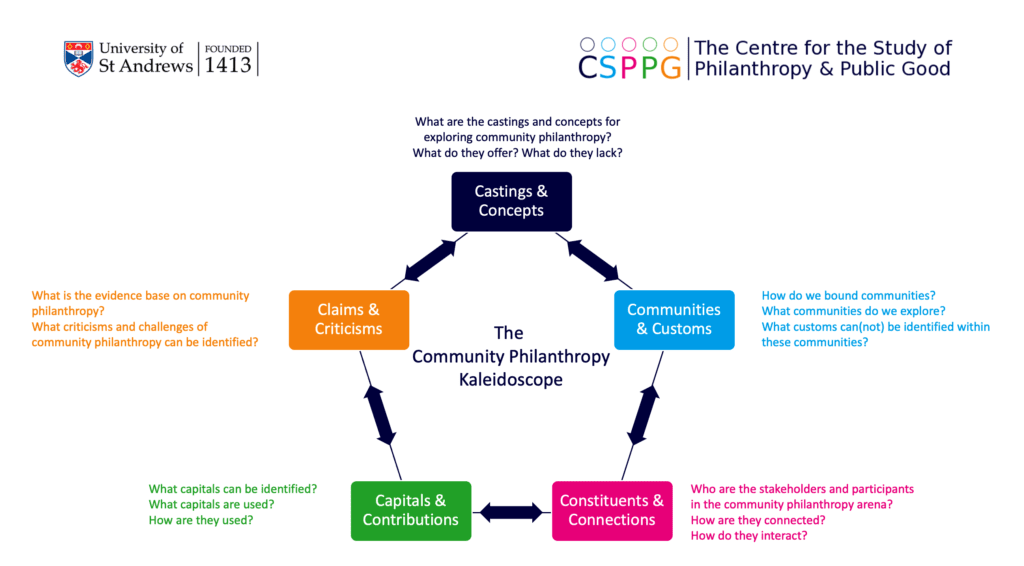The Community Philanthropy Kaleidoscope
by Tobias Jung
An ‘optical instrument for creating and exhibiting beautiful forms’[1], a kaleidoscope offers a seemingly endless variety of patterns by rearranging the position and reflection of different items. For this to work, care needs to be taken. Noticing a growth in spurious forms of kaleidoscopes, its Scottish inventor, Sir David Brewster, felt compelled to write a treatise explaining a kaleidoscope’s underpinning principles, construction, and forms, and offer guidance on how to employ it in a creative and useful way. This equally applies to community philanthropy.
Spread across multiple settings, fields and disciplines, the notion of community philanthropy is appealing and multi-faceted. It presents an ever-changing arrangement of principles, practices, patterns and perceptions that cover a diversity of interrelated ideas and ideals. Notions of ‘grassroots’[2], ‘horizontal’[3], ‘indigenous’[4], ‘participatory’[5], ‘place-based’[6], and ‘social justice’ philanthropy[7] sit alongside more institutional castings of community philanthropy as ‘community chests’[8], ‘community foundations’[9] or ‘giving circles’[10]. In short, there are as many expressions of community philanthropy ‘as there are civilisations and ages in human history’[11]. However, with a US-centric discourse, and academia and practice often operating in silos, inclusive and robust knowledge and understanding of community philanthropy remains emergent; there is a need for more diversity in views and voices, as well as for better critically reflective synthesis of empirical and theoretical insights. Accounting for community philanthropy’s kaleidoscopic nature, we thus need to consider a number of facets, including community philanthropy’s: castings and underpinning concepts; communities and their customs; constituents and their connections; capitals and contributions; and reflections on claims and criticisms.

With a diversity of areas engaging with community philanthropy, from community development to social policy, a bewildering set of definitions has emerged. Some emphasise factors such as ‘assets, capabilities and trust’[12], others portray it as ‘essentially fund development for the strengthening of civil society’[13], or cast it as ‘a practice’ rather than an organisational form[14]. Such definitional diversity sits alongside a plethora of perspectives through which community philanthropy can be approached. However, approaching it from colonial or feminist perspectives that highlight and challenge issues of domination and oppression differs markedly from taking a neoliberal stance interested in the transfer and application of business ideas to improve community philanthropy’s efficiency and effectiveness. Asking what is highlighted or masked, what can or cannot be gleaned from the different castings and concepts that are, have been, or should be used to examine community philanthropy is thus an important starting point. Having clarified the lenses through which we approach community philanthropy, we need to unpack its various facets, starting with the idea of community.
Community implies unity, cohesion and belonging, a ‘shared narrative’. Such shared narratives are not singular but represent a spectrum of degrees, variations in strength of belonging to different communities. Communities thus need to be perceived in multi-dimensional ways: they might be real or virtual, close or far, present or absent, spatial or emotional, physical or psychological, and can include ethnic, faith, cultural and social lines, to name a few[15]. Mapping and identifying different communities in relation to community philanthropy and the customs that accompany each of these is thus a second step in building more nuanced understanding of community philanthropy. As part of this, we need to remember that community philanthropy can be philanthropy for, in, by or with communities and encompasses numerous stakeholders.
The community philanthropy universe is composed of a plethora of individual, collective and organisational participants. In relation to community foundations and giving circles debates about their lifecycles, structures, activities and forms are commonplace. However, we also find other players that offer donations, volunteer contributions, community projects and community partnerships that are less frequently thought of in the context of community philanthropy, particularly corporations[16]. Alongside asking us to move beyond the usual suspects when exploring community philanthropy, thinking about the various constituents involved also points to the need to reflect on the constellations that they present. For example, potential constellations of community philanthropy include one-to-one, one-to-many, many-to-many, and many-to-one ways of engaging in philanthropy[17]. The first two emphasise an individual and direct control of resources; the latter two a more collective and indirect one. As the focus shifts towards these actors’ interactions, power and control, the various resources in community philanthropy and how are they are distributed warrant attention.
Mirroring philanthropy discourse, community philanthropy is often seen as a transfer of resources from those better off to those less so. This, however, does not have to be the case. Community philanthropy can be approached from a vertical perspective, one that is top-down or even bottom-up, or from a horizontal one, where the relationship between giver and recipient is more eye-to-eye[18]. In the context of indigenous philanthropy it is often highlighted that ‘nobody is too poor to give’[18], raising questions of whether and how we should cast our understanding of resources available to community philanthropy. Particularly in the Anglophone discourse on community foundations the emphasis has historically tended to be on financial resources. However, bringing in a multiple capitals framework from the community development field that acknowledges the diversity of community capitals – natural, human, social, cultural, political, financial and built[19] – to explore what and how resources are or could be used in, for and by community philanthropy would, once again help to build more nuanced understanding of the field.
One final thing needs consideration when looking at community philanthropy: a lack of robust discourse on the values and impact of community philanthropy. Advocates of community philanthropy suggest that community philanthropy is at least complementary, if not preferable, to other philanthropic approaches, particularly as it provides a rebalancing of power[11,20]. The extent to which the claims and expectations of community philanthropy live up to their promise, whether community philanthropy does indeed shift any power, and whether there are any darker sides that community philanthropy might present or create, all need further exploration and require stronger collaborations between academia, practice and policy.
Acknowledging that community philanthropy is a kaleidoscope, and looking at the various facets presented and how they relate to each other, allows us to gain a more nuanced and critically reflective perspective of the field, helps to strengthen practice, and hopefully encourages academics and practitioners, empiricists and theorists to join up their expertise and experiences.
This piece was originally published in the European Community Foundation Initiative’s report ‘Community Foundations in Europe – State of the Field 2022‘
References
1. Brewster, D., A Treatise on the Kaleidoscope. 1819, Edinburgh: Archibald Constable & Co.
2. Ruesga, G.A. and B. Knight, The View from the Heights of Arnstein’s Ladder: Resident Engagement by Community Foundations. National Civic Review, 2013. 102(3): p. 13-16.
3. Fowler, A., Changing direction: adapting foreign philanthropy to endogenous understandings and practices, in Philanthropy in South Africa. Horizontality, Ubuntu and Social Justice, S. Mottiar and M. Ngcoya, Editors. 2016, HSRC Press: Cape Town. p. 155-168.
4. Mottiar, S. and M. Ngcoya, Indigenous philanthropy: challenging Western preconceptions, in The Routledge Companion to Philanthropy, T. Jung, S.D. Phillips, and J. Harrow, Editors. 2016, Routledge: London. p. 151-161.
5. Gibson, C.M., Participatory Grantmaking: Has Its Time Come? 2017: Ford Foundation.
6. Mack, K., et al., Redefining Expectations for Place-based Philanthropy. The Foundation Review, 2014. 6(4).
7. Suarez, D.F., Grant Making as Advocacy. The Emergence of Social Justice Philanthropy. Nonprofit Management & Leadership, 2012. 22(3): p. 259-280.
8. Seeley, J.R., et al., Community Chest: a case study in philanthropy. 1957, Toronto: University of Toronto Press.
9. Goff, F.H., The Dead Hand. 1921: The Cleveland Trust Company.
10. Eikenberry, A.M., Giving Circles. Philanthropy, Voluntary Association, and Democracy. 2009, Bloomington: Indiana University Press.
11. Layton, M.D., Philanthropy at the community level, in The Routledge Companion to Philanthropy, T. Jung, S.D. Phillips, and J. Harrow, Editors. 2016, Routledge: London. p. 139-150.
12. Hodgson, J. and B. Knight, eds. Special Feature #ShiftThePower: the rise of community philanthropy. Alliance. Vol. December. 2016.
13. Kilmurray, A., Community Philanthropy. The context, concepts and challenges: A literature review. 2015, Global Fund for Community Foundations and Global Alliance for Community Philanthropy.
14. Doan, D.R., What is community philanthropy? A guide to understanding and applying community philanthropy. 2019: Johannesburg.
15. Hughes, J. and T. Jung, The Community Philanthropy Potpourri. Emerging themes from academic and practice literatures on community philanthropy. 2020, Centre for the Study of Philanthropy & Public Good, University of St Andrews St Andrews.
16. Deigh, L., et al., Corporate social responsibility: engaging the community. Qualitative Market Research: An International Journal, 2016. 19(2): p. 225-240.
17. African Grantmakers Network, Sizing the Field. Frameworks for a new narrative of African philanthropy. 2013, South African Trust.
18. Wilkinson-Maposa, S., et al., The Poor Philanthropist. 2005, Cape Town: The Southern Africa-United States Centre for LEadership and Public Values, Graduate School of Business, University of Cape Town.
19. Emery, M. and D. Flora, Spiraling-Up: mapping community transformation with community capitals framework. Community Development, 2006. 37(1): p. 19-35.
20. Wilkinson-Maposa, S. and B. Dolley, #ShiftThePower: community giving as a consciousness-raising tool. The Foundation Review, 2017. 9(3): p. 77-87.
